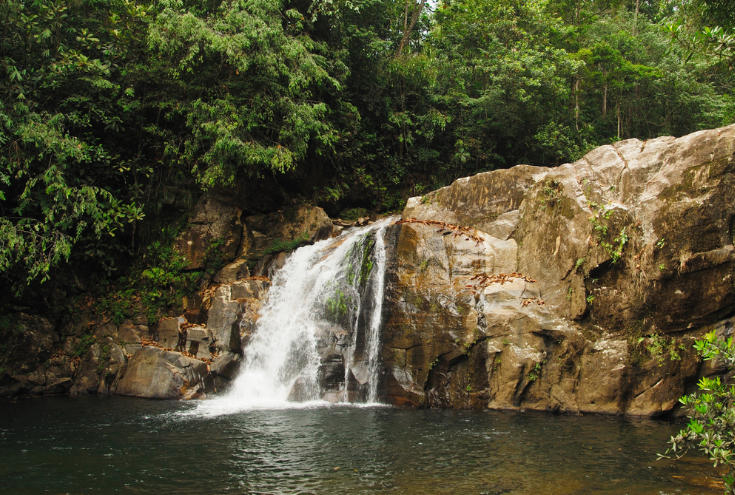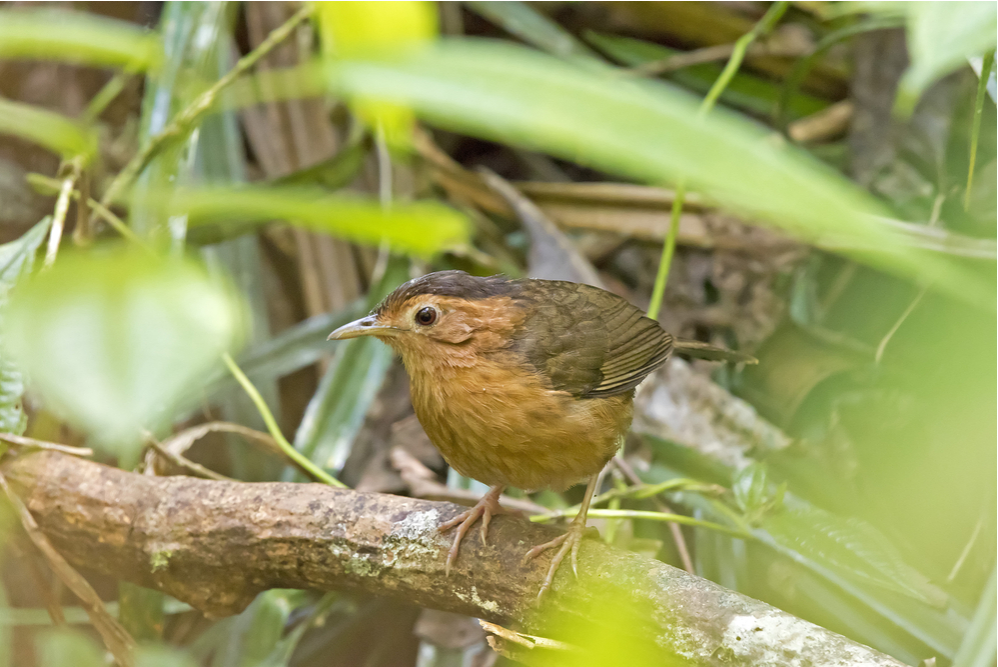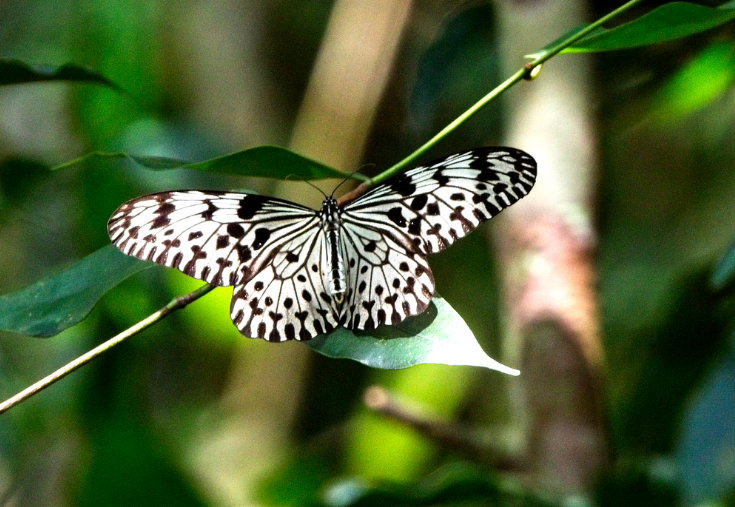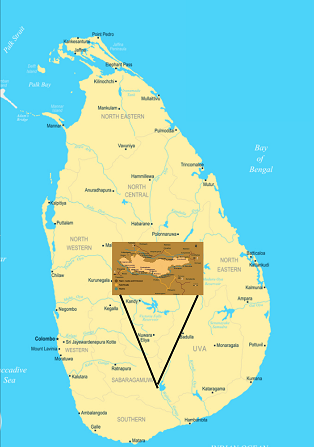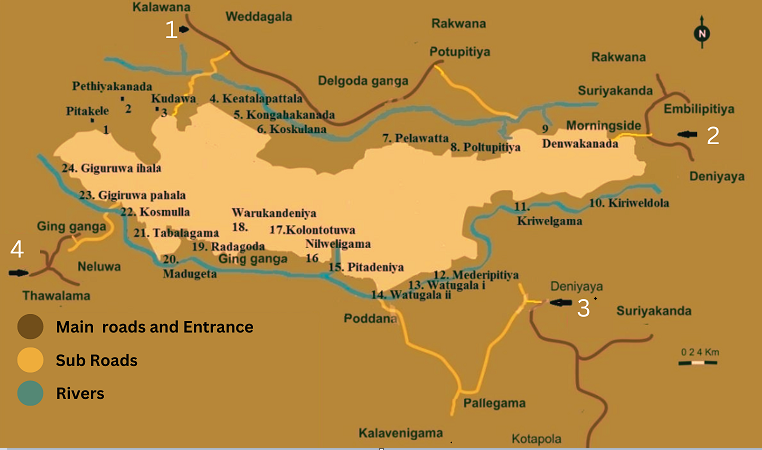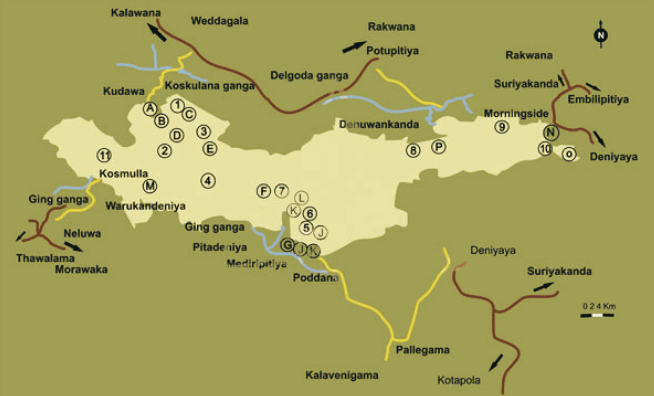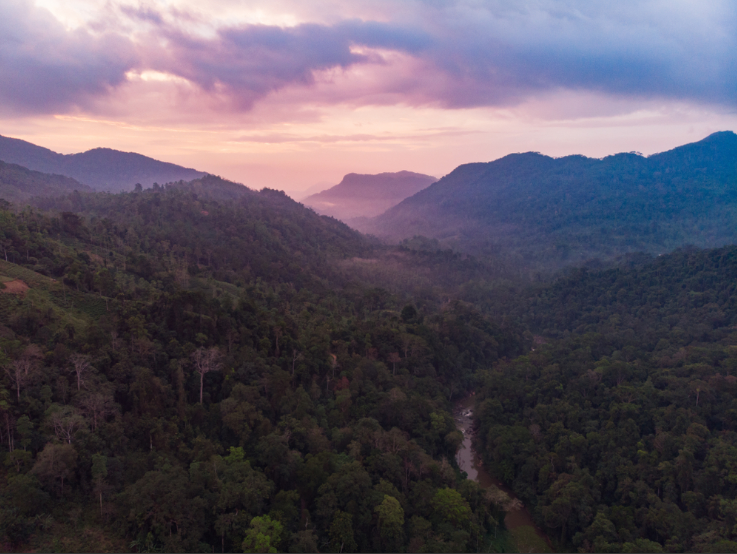
Sinharaja Rain Forest Reserve is one of the slightly distributed and biologically remarkable lowland rainforests currently in Sri Lanka. The forest is saturated in in-depth folklore and secret. The Sinharaja forest was initially declared a Man and Biosphere Reserve (MAB) in 1978 as suggestive and has been recognized by UNESCO as the region of its International Network of Biosphere Reserves.
The lush nature covers around 11187 ha passing the boundaries of three Districts, namely Ratnapura, Matara and Galle. This biosphere reservation is between north latitude 6º21´-6º27′ and east longitude 80º21´-80º37′. There are four passageways to pass into this forest: Ratnapura – Weddagala route, Ratnapura-Rakwana-Sooriyakanda-Ilumbakanda road, Hiniduma – Neluwa road and Deniyaya-Pallegama road. However, the reserves of this rainforest’s main entry from the Ratnapura side, most of the area belongs to Ratnapura District.
Sinharaja forest consists of a sequence of ongoing cliffs aligned roughly in an east-west frontage and lies between the branches of the Kalu Ganga River in the North and the Gin Ganga River in the south.
Flora of Sinharaja Forest Reserve
The greenery of Sinharaja is that humid, wet, green forest with a high degree of endemism. The average height of the trees ranges between 35m – 40m, and some trees rise over 50m. Some clans, such as Dipterocarpaceae, show more than 90% endemism.
The entire vegetation density, including trees, shrubs, spices, and seedlings, has been assessed to be about 240,000 individuals per hectare, of which 95% comprise individuals of the ground layer below 1m in height. The thickness of trees lianas above 30 cm circumference at breast height ranges between 600 – 700 individuals per hectare, while the number of merchantable individuals of trees of girth more significant than 150 cm ranges between 45-55 individuals per hectare.
The untapped hereditable prospect of Sinharaja flora is immense; of the 211 woody trees and lianas recognized within the reserve, 139 (66%) are endemic. Furthermore, high levels of endemism are objective for lower plants like ferns and epiphytes, 25 genera endemic to Sri Lanka, and 13 are represented in Sinharaja.
Fauna of Sinharaja Forest Reserve
Around 130 bird species are discovered here, including numerous of the 33 species endemic to Sri Lanka. There are also affluent reptile inhabitants and myriads of insect species, many yet to be classified—mammals scenes here, including the purple-faced langur monkey and the gigantic squirrel. Examinations on the fauna of Sinharaja have disclosed a high degree of endemism among butterflies, fish, amphibians, snakes, birds, and mammals, more prominent than 50%.
The common deer species is the Sambhur. In addition, the Barking deer and monk deer are also found within the reserve. Sinharaja is also home to the untouchable leopard. Leopards are seldom seen, but tracks and other signs have proved their familiar sight. In addition, Badger Mongoose and the Golden Palm Civet have been occasionally sighted.
72% were resident non-endemic birds, and 13% of birds were migrants recorded in the western sector of the reserve. However, among the most exciting and multicolour splendours to be discovered in the Sinharaja is the diverse species of foraging birds around 100s residents. Studies have demonstrated that some communities included 48 and 12 endemic species.
The periodic endemic birds in Sinharaja are the Sri Lanka Blue Magpie, the Red-faced Malkoha, the Ashy-headed Babbler, the White-headed Starling and the Green-billed Coucal.
The Agamids are the best-represented set of snakes, the most typical Green Garden Lizard living. Special significance is the sightings of Calotes Liolepis, an arboreal species, the most occasional agamids in the country.
The species of skink, the spotted, can be seen often. The only Tortoise recorded in reserve is the Hard-shelled Terrapin, while Among the serpents, The Hump-nosed and Viper Green Pit Viper are standard in this forest and endemic to Sri Lanka. The Wrinkled frog and The Sri Lankan Reed frog are also seen in Sinharaja in the wettest season.
Visitor information – Sinharaja Forest Reserve
Examining Sinharaja on foot is preferable to a genuinely authentic jungle adventure. Therefore, they are four starting points for visits to Sinharaja Forest Reserve.
The Access paths to enter the Sinharaja Forest Reserve.
1.Kudawa entrance –
Colombo –> Kalawana –> Kudawa ( View on map )
2.Morning Side Entrance
Galle / Matara –> Deniyaya –> Morning Side Estate
Ratnapura –> Rakvana –> Morning Side Estate (View on map )
3.Pitadeniya Entrance –
Galle / Matara –> Deniyaya –> Pitadeniya ( View on map )
4.Lankagama entrance –
Galle / Matara –> Neluwa –> Lankagama( View on map )
Most suitable time to Visit Sinharaja Forest Reserve
The adequate time to visit the forest is between December and early April or August to September. Sinharaja rain forest gets the advantage of both monsoons. Rains are expected during the southwestern monsoons from May-July. Since this monsoon brings heavy torrential rainfall, visiting the Sinharaja forest reserve isn’t advised from May to August, and the northeastern monsoons bring rain from November-December. The aridest month is February, with the least precipitation.
What to clothe and bring
Sinharaja is overrun with leeches, therefor long clothing and shield stockings or repellents are necessary. Also, since snakes such as the green viper are expected in the location, wear sturdy boots and long jeans. Also, a walking stick is helpful for protection against them.
Polyethylene wrappings and bags aren’t allowed to carry inside the forest reserve. Water can be held in reusable bottles, while temporary plastic and soft drink bottles are not permitted. Furthermore, We advise you to utilize an experienced guide to walk through the forest.
Important Locations at the Sinharaja Forest Reserve
A – Kudawa Conservation Centre
B – Jeep track from Kudawa to Kudawa Research Station
C – Mulawella Peak
D – Kudawa Research Station
E – Gal Yen Yaya
F – Sinhagala Peak
G – Pitadeniya Conservation Centre
H – Pitadeniya Ticket Counter
I – Track from Mediripitiya to Pitadeniya Conservation Centre
J – Kohila Aramba
K – Kekuna waterfalls
L – Patan-Oya waterfalls
M – Duwili waterfalls (Kosmulla)
N – Morningside Conservation Centre
O – Natural Pool
P – Duwili waterfalls (Morningside)
Trails at The Sinharaja Forest Reserve
1 – Wathurawa- Mulawella
2 – From Kudawa Conservation Centre to Nawanda Tree
3 – From Sinhagala Trail to Gal Len Yaya
4 – Sinhagala trail from Kudawa
5 – Kohila Aamba Trail
6 – Kekuna waterfalls and Pata-oua waterfalls Trail
7 – Sinhagala Trail from Pitadeniya
8 – Duwili waterfalls Trail from Denuwakanda
9 – Duwili waterfalls Trail from MCC
10 – From Morningside to the natural pool
11 – Trail from Kosmulla via Duwili waterfalls to Siththara gal Lena (cave)
Suggested Read : Most Popular National parks in Sri Lanka

Ravindu Dilshan Illangakoon
As co-founder and Head of Content at Sri Lanka Travel Pages, I ensure that every blog post we publish is AMAZING.

